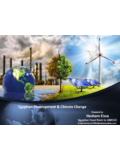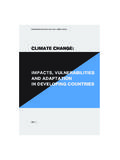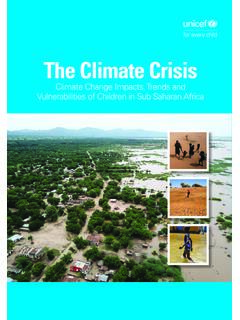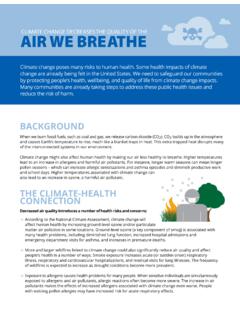Transcription of Myanmar Climate Change Strategy (2018 2030)
1 The Republic of the Union of Myanmar 2019 Myanmar Climate Change Strategy (2018 2030) Page1 Myanmar Climate Change Strategy (2018- 2030) Myanmar Climate Change Strategy (2018-2030) Acknowledgements The Ministry of Natural Resources and Environmental Conservation (MONREC) acknowledges the important contribution made by all members of the Programme Steering Committee of the Myanmar Climate Change Alliance (MCCA) for their guidance and all members of the MCCA's Technical Working Group (TWG) for their contribution in formulating this Strategy . The TWG comprises representatives from all key ministries and departments; Yangon, Mandalay and Nay Pyi Taw city development committees; academic institutions; the Union of Myanmar Federation of Chambers of Commerce and Industry (UMFCCI); Civil Society Organisations, including the Myanmar Environment Rehabilitation Network (MERN), and the Platform of CSOs working on Environment and Climate Change ; Myanmar Engineering Society; and Development Partners, the United Nations Development Programme(UNDP), disaster Risk Reduction Working Group, Environment Sector Working Group, UN-REDD+, WWF- Myanmar .
2 These members provided valuable insights, ideas and strategic orientation to produce an actionable Strategy . MONREC is sincerely grateful to the European Union for the generous support received through funding the MCCA programme, implemented by the United Nations Human Settlements Programme (UN-Habitat) and the United Nations Environment Programme (UN Environment). MCCA has worked as an efficient platform for convening national and sub-national stakeholders for the Strategy formulation process from April 2015 to June 2016, and to mobilize expertise to draft the Strategy . MONREC also wishes to thank the experts of the International Institute for Environment and Development (IIED), the experts who formulated the capacity development need assessments in connection to the Strategy and MERN for facilitating the local consultations.
3 The Ministry of Natural Resources and Environmental Conservation (MONREC) also acknowledges the important contribution made by all stakeholders, including the TWG, PSC, the UMFCCI; civil society organisations, including MERN, and development partners, WWF- Myanmar , consulted for the formulation of the Myanmar Climate Change Policy (MCCP). In particular MONREC would like to thank the Environment Ministers and high level representatives of the Environmental Conservation Department for their valuable Page2 Myanmar Climate Change Strategy (2018- 2030) Myanmar Climate Change Strategy (2018-2030) contributions and for travelling from different states and regions to attend the national consultation workshops; and the experts of the International Institute for Environment and Development (IIED) drafting team for their tireless efforts in formulating the Myanmar Climate Change Policy that provides long-term direction and guidance for government, civil society, and the private sector to undertake and promote Climate Change actions in adaptation and mitigation in Myanmar and to create opportunities for sustainable and low-carbon development.
4 On behalf of the Government of the Republic of the Union of Myanmar , MONREC extends its gratitude to all citizens of Myanmar who participated in meetings at local, sub-national and national levels in more than 20 townships in five states and regions, and those who provided comments through the MCCA website and by other means through out the formulation process of the Myanmar Climate Change Strategy and Master Plan (MCCS and MCCMP) 2018-2030 and the Myanmar Climate Change Policy (MCCP). Table of contents Acknowledgements 1 Table of contents 3 Glossary 7 Acronyms 9 Forewords 12 Executive summary 20 Part I: Development in the context of Climate Change 27 1. National circumstances 27 Climate 28 Demography 29 Economic development 31 Social development 34 Environmental development 34 Governance systems 35 2.
5 Myanmar 's development vision 37 Economic development 37 Social development 38 Environmental development 39 Climate Change 41 3. Implications of Climate Change on development 48 Agriculture, fisheries and livestock 53 Environment and natural resources 58 Energy, transport and industry 64 Cities, towns and human settlements 73 Climate hazards and health 79 Education, science and technology 85 4. Readiness and capabilities for addressing Climate Change 90 Page3 Myanmar Climate Change Strategy (2018-2030) Table of contents Acknowledgements 1 Table of contents 3 Glossary 7 Acronyms 9 Forewords 12 Executive summary 20 Part I: Development in the context of Climate Change 27 1. National circumstances 27 Climate 28 Demography 29 Economic development 31 Social development 34 Environmental development 34 Governance systems 35 2.
6 Myanmar 's development vision 37 Economic development 37 Social development 38 Environmental development 39 Climate Change 41 3. Implications of Climate Change on development 48 Agriculture, fisheries and livestock 53 Environment and natural resources 58 Energy, transport and industry 64 Cities, towns and human settlements 73 Climate hazards and health 79 Education, science and technology 85 4. Readiness and capabilities for addressing Climate Change 90 Page4 Myanmar Climate Change Strategy (2018-2030) Policy landscape 90 Institutional arrangements 95 Financing mechanism 96 Monitoring and evaluation 99 Technology and innovation 99 Awareness and capacity 100 Partnerships 101 Youth and children 102 Gender considerations 103 Part II: The Strategy 106 5.
7 Myanmar Climate Change Strategy 108 Strategic vision 108 2030 Goal 108 Objectives 108 Action areas 109 Priority sectors and outcomes 110 Climate -smart agriculture, fisheries and livestock for food security 111 Sustainable management of natural resources for healthy ecosystem 112 Resilient and low-carbon energy, transport and industrial systems for sustainable growth 112 Resilient, inclusive and sustainable cities and towns where people can live and thrive 113 Climate risk management for people's health and wellbeing 114 Education, science and technology for a resilient society 115 Strategic indicators 116 Achieving sectoral outcome 116 Phases 117 Part III: Implementing the Strategy 119 6. Overall mission: to direct action for addressing Climate Change 120 7.
8 Guiding principles 121 8. Strategic master plan and sectoral outcomes 122 9. The five pillars of implementation 131 Policy framework 131 Multi-stakeholder institutional mechanism 132 Climate finance mechanism 139 Capacity-strengthening framework 141 Monitoring, evaluation and learning framework 143 References 145 List of Figures Figure 1: State and Regions of Myanmar 27 Figure 2: (a) Myanmar 's three agro-ecological zones and (b) Eight physiographic region 28 Figure 3: Population Density (people/km2)in Myanmar by State/Region 30 Figure 4: Proportion of state/region population to total population 31 Figure 5: Economic transformation in Myanmar 32 Figure 6: Structure of Myanmar 's GDP, 2012-2013 32 Figure 7.
9 Conceptual framework of Myanmar Climate Change Strategy (2018-2030) 118 Figure 8: Inter-linkage of coordination body and implementing agencies 134 Figure 9: Key streams for financing the strategic master plan 141 List of Tables Table 1: Drivers of growth in the state and regions 33 Table 2: Climate Change projections for Myanmar , based on RCP 45 Table 3: Climate Change projections for Myanmar , based on RCP 46 Table 4: Projected sea level rise for Myanmar 48 Page5 Myanmar Climate Change Strategy (2018-2030) 6. Overall mission: to direct action for addressing Climate Change 120 7. Guiding principles 121 8. Strategic master plan and sectoral outcomes 122 9. The five pillars of implementation 131 Policy framework 131 Multi-stakeholder institutional mechanism 132 Climate finance mechanism 139 Capacity-strengthening framework 141 Monitoring, evaluation and learning framework 143 References 145 List of Figures Figure 1: State and Regions of Myanmar 27 Figure 2: (a) Myanmar 's three agro-ecological zones and (b) Eight physiographic region 28 Figure 3: Population Density (people/km2)in Myanmar by State/Region 30 Figure 4: Proportion of state/region population to total population 31 Figure 5: Economic transformation in Myanmar 32 Figure 6: Structure of Myanmar 's GDP, 2012-2013 32 Figure 7.
10 Conceptual framework of Myanmar Climate Change Strategy (2018-2030) 118 Figure 8: Inter-linkage of coordination body and implementing agencies 134 Figure 9: Key streams for financing the strategic master plan 141 List of Tables Table 1: Drivers of growth in the state and regions 33 Table 2: Climate Change projections for Myanmar , based on RCP 45 Table 3: Climate Change projections for Myanmar , based on RCP 46 Table 4: Projected sea level rise for Myanmar 48 Page6 Myanmar Climate Change Strategy (2018-2030) Table 5: Climate Change impacts in Myanmar 49 Table 6: Climate Change impacts on health sector 81 Table 7: Myanmar 's Climate Change policies and Climate Change -relevant strategies and plans 92 Table 8: Bilateral and multilateral spending on Climate -related projects in Myanmar 97 Table 9: Strategic master plan comprising expected results and strategic indicators for each of the six priority sector 123 Table10: Mapping SDGs and MCCS sectoral outcomes 129 Table 11: Mechanism for implementing, coordination and monitoring the MCCS 135 Page7 Myanmar Climate Change Strategy (2018- 2030) Myanmar Climate Change Strategy (2018-2030) Glossary1 Adaptation: The process of adjustment to actual or expected Climate and its effects.




